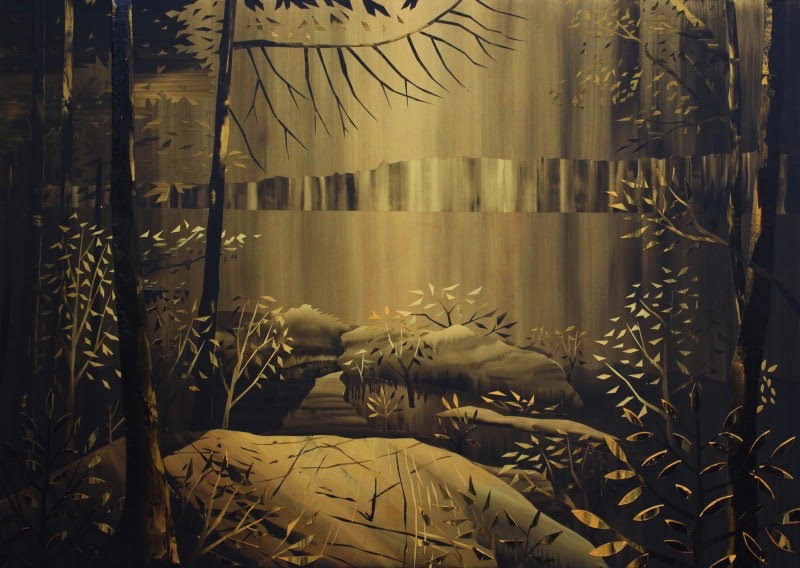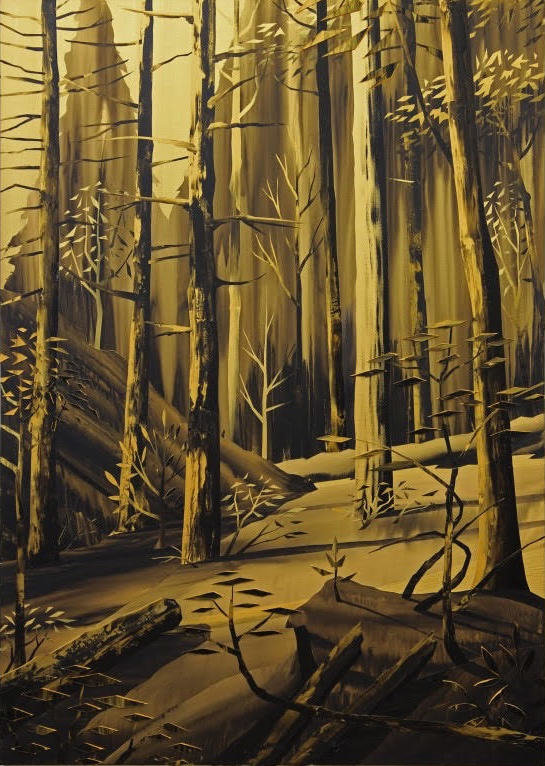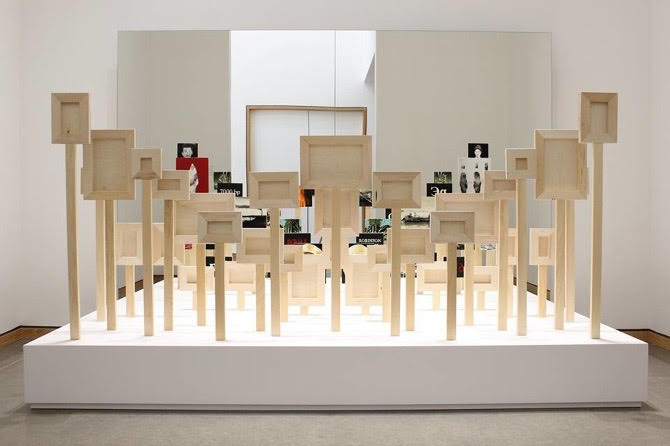Before entering into the Angell Gallery, one walks through a twisted parking lot maze, a rather poetic contrast to the quiet splendor of Gavin Lynch’s wooded landscapes. The exhibition titled The Prelude & The Recluse is a pointed reference to the masterpiece of William Wordsworth, the Romantic poet spent his life constantly reworking this three part epic poem. Coming into the space, the viewer is immediately captivated by the large canvas “Prelude no. 6 (A Return to the Edge of the Lake)” whose monochrome contrast and thick build up of gold paint initially beguile.
 Gavin Lynch, Prelude no. 6 (A Return to the Edge of the Lake), 2015/2016, oil and acrylic on canvas, 52″ x 72″. Image courtesy of Angell Gallery
Gavin Lynch, Prelude no. 6 (A Return to the Edge of the Lake), 2015/2016, oil and acrylic on canvas, 52″ x 72″. Image courtesy of Angell Gallery
The artist, uses a masking tape method, whereby the background of the painting is completed first in acrylic, next, the leaves and other small elements of the painting are built up with oil paint framed neatly by masking tape. These details stand centimeters off the canvas giving the work at tactility and plasticity, without lacking the precision that a general impasto technique affords. “A Return to the Edge of the Lake”, presents a re-imagined Romantic landscape, replete with the proto-typical repoussoir, as four slender trees positioned at the left side of the work attempt to navigate the viewer’s eye further into the image. The gallery describes the gold monochrome of “Prelude no. 6” and “Prelude no. 4 (Lost on the Slope)” as endowing ‘them with a celebratory quality’, yet the longer I stood in their presence the more I was convinced that they echoed a profound melancholy. Here, the gold is sobered by the singular polarity of light and dark highlight its artificial nature leaving the viewer feeling isolated.storethe best replica watches in the world
 Gavin Lynch, Prelude no. 4 (Lost on the Slope), 2015, oil and acrylic on canvas, 84″ x 60″. Image courtesy of Angell Gallery
Gavin Lynch, Prelude no. 4 (Lost on the Slope), 2015, oil and acrylic on canvas, 84″ x 60″. Image courtesy of Angell Gallery
In returning to the title of the show, it becomes important to consider Lynch’s allusion to Prelude. Wordsworth’s poem was an autobiographical exploration, stressing the necessity of nature to fulfill the author’s spiritual needs. Is the same true of Lynch? This Ottawa based artist, presents us a body of work devoted exclusively to landscape, it registers then that his autobiographical or self-portraiture would come to us in this format. Stepping into the heart of the Angell Gallery, the impossibly tall walls feature the five remaining works of Prelude, the viewer is encircled in the wooded landscape of Lynch’s self-consciousness. Moving on from “Prelude no. 4.”, the four other compositions enter into a new realm, that of technicolour. This welcomed change is powerfully felt as I circled counter clockwise around the room stopping before “Prelude no. 1. (Farewell to the Janus Idol).”
 Gavin Lynch, Prelude no.1 (Farewell to the Janus Idol), 2015/2016, oil and acrylic on canvas, 60″ x 84″. Image courtesy of Angell Gallery
Gavin Lynch, Prelude no.1 (Farewell to the Janus Idol), 2015/2016, oil and acrylic on canvas, 60″ x 84″. Image courtesy of Angell Gallery
The severity and unforgiving edges of Lynch’s lines and forms are the constant element of the exhibition, but with “Prelude no. 1” the depth and richness of his palette make the work easier to process and appreciate than the earlier gold monochromes. We are able to stay engaged with the composition, as our eye gets lost between the many subtle shades and hues of Lynch’s quilted arcadia. In much the same way that Wordsworth charted the course of his life with Prelude, so to does Lynch as “Farewell to the Janus Idol” captures the inevitable passing of time, the leaves framing the forest have turned red and yellow. The autumnal colours are aglow demanding our attention and in a memento mori like fashion the contemplation of the passing time seem inevitable.
 Gavin Lynch, The Recluse. Image courtesy of Angell Gallery
Gavin Lynch, The Recluse. Image courtesy of Angell Gallery
The exhibition ends in the Angell’s Project Gallery, a smaller, enclosed space with Lynch’s “The Recluse.” A large mirror acts as the conduit to the work, reflecting a series of small images for the viewer to consume. A great change of pace from his monumental landscapes the work acts as a scrapbook for Lynch’s travel into Killarney National park, the site and inspiration for the entire show. Ultimately, the exhibition’s success lies in “The Prelude,” whose landscapes convey a reflexive awareness of their creator, the solitary and melancholic artist, whose reverence and communion with nature is exacted through the sharp and acute lines of his surreal landscapes.
Meghan O’Callaghan
*Exhibition information: February 5 – February 27, 2016, Angell Gallery, 1444 Dupont St., Unit 15 (Entrance off Campbell Ave.). Gallery hours: Wed – Sat: 12 – 6 p.m.
